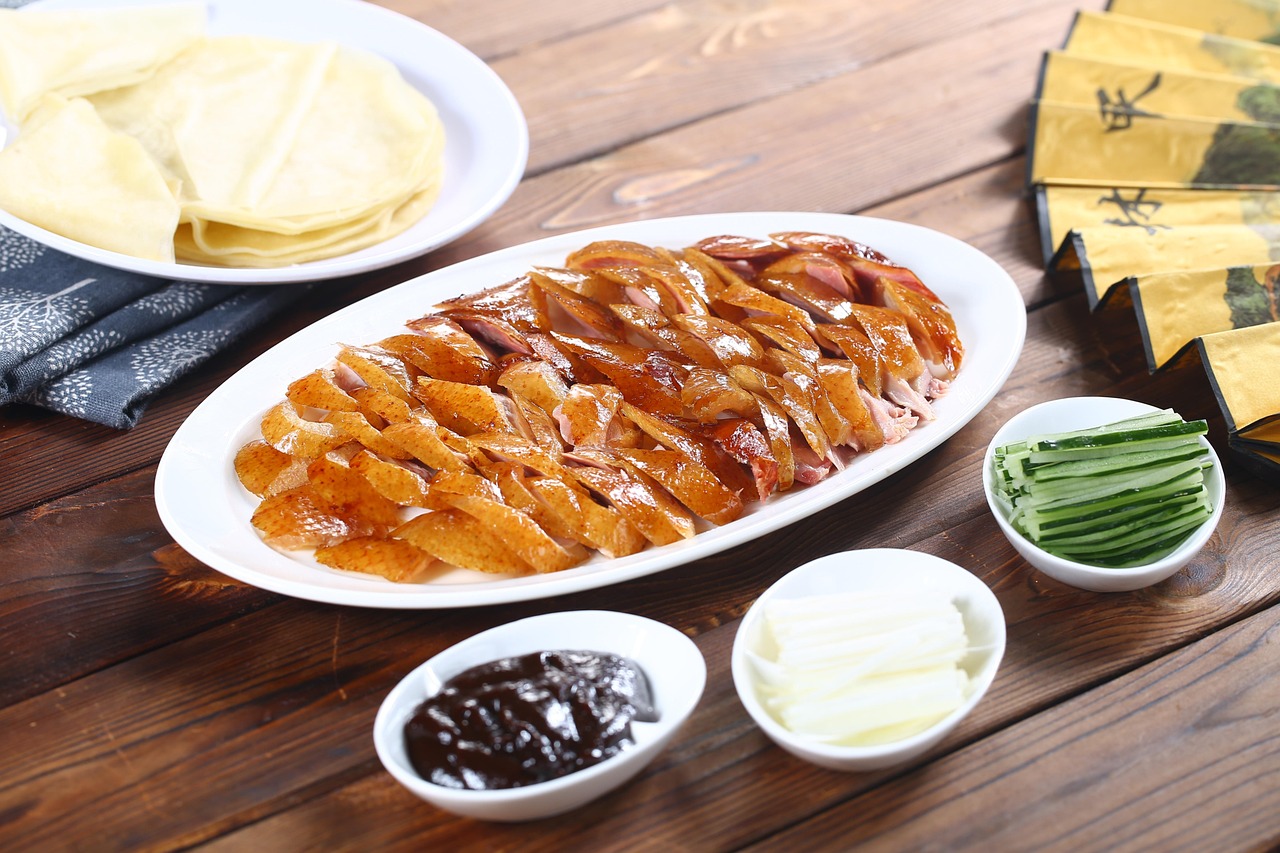No culinary journey to China is complete without indulging in Peking Duck (Beijing Kao Ya, 北京烤鸭). More than just a meal, it’s a centuries-old tradition, an art form, and a theatrical dining experience that tantalizes all the senses. From its crispy, lacquered skin to its succulent meat, perfectly complemented by sweet sauce and delicate pancakes, Peking Duck offers a truly iconic taste of imperial China.
This comprehensive guide will walk all international tourists through everything they need to know to savor this legendary dish, from its rich history to where to find the best, and how to eat it like a local.
What is Peking Duck? The Culinary Masterpiece Explained
Peking Duck is a dish of specially bred and fattened ducks, roasted to perfection until their skin becomes incredibly crisp and golden, while the meat remains tender and juicy. The magic lies in the meticulous preparation process:
- Preparation: Ducks are typically air-pumped to separate the skin from the fat, then blanched, basted with a sugary glaze (often maltose syrup), and air-dried for hours or even days. This crucial step is what contributes to the signature crispy skin.
- Roasting: Traditionally, the ducks are roasted in closed ovens or hung over an open fire, often fueled by fruitwood (like jujube or peach wood), which imparts a subtle, aromatic flavor.
- Serving: The highlight of the meal is often the tableside carving. A skilled chef will expertly slice the duck into thin pieces, ensuring each slice has a bit of crispy skin and tender meat.
A Brief History: From Imperial Palaces to Global Fame
The origins of Peking Duck can be traced back to the Yuan Dynasty (1271–1368), when it was a dish reserved for imperial feasts. It gained particular prominence during the Ming Dynasty (1368–1644), becoming a staple in the imperial kitchens. When the capital moved from Nanjing to Beijing in the 15th century, so did the dish, cementing its association with the city now known as Beijing.
Over centuries, chefs perfected the intricate techniques, turning a royal delicacy into a globally celebrated culinary icon. Today, Peking Duck is a symbol of Chinese culinary artistry, enjoyed by dignitaries, celebrities, and food enthusiasts worldwide.
What to Expect at a Peking Duck Restaurant
Dining on Peking Duck is an experience in itself, often involving a bit of culinary theater.
- The Whole Duck: You’ll typically order a whole duck (or half a duck if dining solo or as a pair, though a whole duck is recommended for the full experience, usually enough for 2-4 people).
- Tableside Carving: In reputable restaurants, a chef will bring the perfectly roasted duck to your table and carve it with impressive speed and precision right before your eyes. They aim for over 100 thin slices, each with a piece of the coveted crispy skin.
- Accoutrements: Alongside the sliced duck, you’ll receive:
- Thin Pancakes (Bò Bǐng): Steamed, paper-thin flour pancakes used as wrappers.
- Sweet Bean Sauce (Tian Mian Jiang): A rich, savory, and slightly sweet sauce, specifically designed to complement the duck.
- Condiments: Typically julienned spring onions (scallions) and cucumber sticks. Sometimes other additions like pickled radish or rock sugar for dipping the crispy skin.
- The “Second Course”: Don’t be surprised if the restaurant offers to prepare additional dishes using the remaining duck meat and bones. Common options include duck bone soup, stir-fried duck with vegetables, or duck mince served in lettuce wraps. This often comes at an additional charge but ensures no part of the duck goes to waste.
How to Eat Peking Duck: The Perfect Bite
Assembling your own Peking Duck wrap is part of the fun! Here’s the traditional method:
- Lay the Pancake: Place one warm, thin pancake flat on your plate.
- Spread the Sauce: Using your chopsticks, spread a thin layer of the sweet bean sauce onto the pancake. Don’t overdo it, as the sauce is quite rich.
- Add Duck: Place a few slices of duck meat and skin on the pancake. For a true taste sensation, try a piece of just the crispy skin dipped in a tiny bit of sugar first – a sublime experience!
- Add Condiments: Lay a few strands of spring onion and cucumber on top of the duck.
- Roll it Up: Fold the bottom edge of the pancake up, then fold in the sides, creating a small, open-ended roll (like a mini-burrito or spring roll).
- Enjoy! Pick it up and savor the harmonious blend of crispy, tender, sweet, and savory flavors.
Peking Duck Etiquette:
- It’s common to serve your fellow diners a few slices before serving yourself.
- Applaud the chef’s carving skills – it’s a sign of appreciation!
- While chopsticks are traditional, it’s perfectly acceptable to use your hands to roll and eat the pancakes.
- Don’t point your chopsticks at people.
You Might Also Like:
- Exploring Beijing on a Budget: Your Guide to Free & Affordable Adventures
- China Food Tours 2026: Culinary Journeys in Beijing, Shanghai, Xi’an, and Chengdu
- Beijing Tours 2025: Customizable Day Tours and City Experiences
Where to Find the Best Peking Duck in Beijing (and Beyond!)
While authentic Peking Duck originated in Beijing, its popularity means you can find excellent versions in major Chinese cities and even globally. However, for the ultimate experience, Beijing is the place to be.
Beijing’s Renowned Peking Duck Restaurants:
- Quanjude (全聚德): Established in 1864, Quanjude is the most famous and historic name in Peking Duck. It offers a very traditional experience and has multiple branches, with the Qianmen Street location being iconic. Expect classic preparation and a bustling atmosphere.
- Da Dong Roast Duck (大董烤鸭店): Known for its innovative approach, Da Dong specializes in a leaner, crispier version of the duck with less fat. It offers a more refined, fine-dining experience with beautifully presented dishes and creative side dishes. Don’t miss their “sugar-coated duck skin.”
- Siji Minfu (四季民福): A favorite among locals and tourists alike for its excellent quality at more reasonable prices. Siji Minfu offers a traditional yet cozy ambiance and has several convenient locations, including one near Tian’anmen Square.
- Bianyifang (便宜坊): With a history dating back to 1416, Bianyifang is even older than Quanjude and is known for its “closed-oven” roasting method. It offers a more rustic and historic charm.
- Made in China (Grand Hyatt Beijing): Located in a luxury hotel, this restaurant offers a sophisticated and elegant setting for a high-end Peking Duck experience, popular for special occasions.
Cost for Tourists: The price of a whole Peking Duck can vary. In Beijing, expect to pay approximately:
- Budget-friendly (local spots): $20-40 USD for a whole duck.
- Mid-range (Siji Minfu, some local chains): $35-60 USD for a whole duck, often with condiments as extras.
- High-end (Quanjude, Da Dong, hotel restaurants): $60-100+ USD for a whole duck, often including condiments and higher service.
Remember that these prices are generally for the duck itself; you’ll likely order additional side dishes, drinks, and potentially the “second course” preparations, which will add to the overall bill.
Savoring Peking Duck is more than just a meal; it’s an immersive cultural experience that connects you to centuries of Chinese imperial tradition. Make sure to include this culinary highlight on your itinerary for an unforgettable taste of China!





